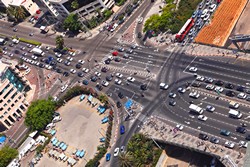Planning transport solutions for cities
Growing urban sprawl means longer car trips and this affects the sustainability of cities. Planning interventions in urban form (e.g. new urbanism, compact city) have been suggested as a possible way to reduce vehicle use. Research in this area runs along a spectrum from total focus on the local spatial scale to total focus on the regional spatial scale, with most studies falling somewhere in between. The Marie Curie project NEWCOMPACTISM (New Urbanism vs Compact City: Investigation of the relationships between urban micro- and macro- scale effects on travel behaviour) explored the respective roles of local and regional characteristics of urban form on vehicle travel. The main hypothesis of this research is that urban micro- and macro-scale characteristics exert complementary effects on vehicle trip frequency and 'Vehicle kilometres travelled' (VKT). This is due to the existence of two action spaces that individuals consider when they make travel decisions: the local (multimodal) action space, which is defined as the area that the typical walking, bicycle and public transport user can reach within an acceptable travel time for a one-way trip, and the regional (mono- or oligo- modal) action space, which complements the local action space and is dominated by automobiles. The underlying assumption is that people consider an acceptable travel time to spend on each trip they want to make, as a factor that is incorporated in their travel decision processes. The researchers explored the hypothesis in two case studies in different spatial contexts: the San Francisco Bay Area in the United States and the Randstad area in the Netherlands. Multilevel and ordered logit models results for the two case studies showed that the two urban scale characteristics exert complementary effects on VKT, but not on vehicle trip frequency. However, because people in both areas display significantly lower VKT in the local than in the regional action space for all trip purposes (work, shopping, social/recreation), it is concluded that regional-scale interventions are more important for the policy objective of VKT reduction, although local-scale design policies might also contribute to achieving this policy goal. Node density and block size (for the local action space models) and regional jobs accessibility (for the regional action space models) demonstrated the strongest and most significant relationships with VKT. Moreover, results from 36 in-depth interviews conducted in Berkeley, California and Delft, The Netherlands as part of this research, supported the validity of the concept of acceptable travel time. In conclusion, evidence from this research suggests that we promote planning on both spatial scales, though with priority given to the regional level to make VKT reduction policies more effective.
Keywords
Urban sustainability, transportation planning, city infrastructure, local planning, regional planning



